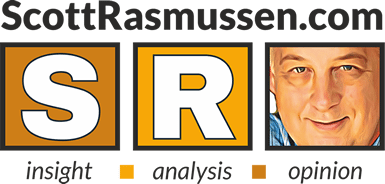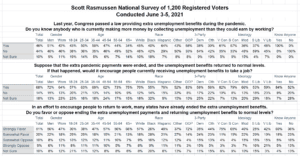Seventy-one percent (71%) of voters favor ending the pandemic related supplemental unemployment payments and returning unemployment benefits to normal levels. A Scott Rasmussen national survey found that 19% are opposed and 10% are not sure.
Those totals include 51% who Strongly Favor ending those supplemental benefits and 9% who are Strongly Opposed.
The debate over these benefits has taken on increased urgency in the wake of two consecutive disappointing jobs reports.
Twenty-five states have already ended the supplemental benefits or scheduled a date for doing so. As with just about everything related to the pandemic, there is a huge partisan divide. All 25 states that have dropped the extra benefits have Republican governors.
Among the public, however, support for ending the benefits is found across partisan, ideological, and demographic lines. A majority of voters in every measured demographic group favor ending those benefits. Support comes from 86% of Republicans, 67% of Independent voters, and 59% of Democrats.
Sixty-eight percent (68%) of voters believe that ending the supplemental benefits will encourage people currently receiving unemployment benefits to take a job.
Many policy debates in Washington seem distant to voters and almost theoretical in nature. However, this topic is much more tangible to many. Forty-six percent (46%) of voters know someone who is making more money by collecting unemployment than they could earn by working. Among those who know someone in that situation, 82% favor ending the supplemental benefits.
SIGN UP to receive Scott’s free email newsletter.
CHECK OUT Scott’s latest polls.
Note: Neither Scott Rasmussen, ScottRasmussen.com, nor RMG Research, Inc. have any affiliation with Rasmussen Reports. While Scott Rasmussen founded that firm, he left more than seven years ago and has had no involvement since that time.
Methodology
The survey of 1,200 Registered Voters was conducted by Scott Rasmussen using a mixed mode approach from June 3-5, 2021. Field work for the survey was conducted by RMG Research, Inc. Most respondents were contacted online or via text while 237 were contacted using automated phone polling techniques. Online respondents were selected from a list of Registered Voters and through a process of Random Digital Engagement. Certain quotas were applied, and the sample was lightly weighted by geography, gender, age, race, education, internet usage, and political party to reasonably reflect the nation’s population of Registered Voters. Other variables were reviewed to ensure that the final sample is representative of that population.



